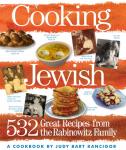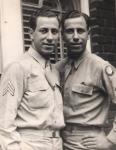
BUY COOKING JEWISH by clicking here now.
Can she bake a rhubarb pie, Billy Boy, Billy Boy?
I don’t come from a long line of pie bakers. I don’t think my grandmother, Mama Hinda, ever baked one…I know my mother never did. Yet to my mind as a young bride, nothing epitomized consummate homemaking skills as much as the baking of pies, something I would not even attempt for decades.
For many years I lived with a dough phobia, the result of a kitchen disaster I call the “kreplach incident.” I had rolled out the dough for these little meat-filled dumplings, carefully placed them in boiling water and they exploded! That experience created a fear of all things rolled that spilled over to piecrusts and pastries and lasted over thirty years.
Although in the ensuing years I rolled cookie dough and turned out homemade knishes by the dozens with ease, somehow pie baking I thought of as a magical gift bestowed from birth on some, but never to be attained by others. Genetics, perhaps?
“I’m just not a dough person,” I would lament… until testing recipes for my cookbook forced me to face my fears (and without a support group). Recipes needed to be tested. I cooked. I baked. I even perfected the dreaded kreplach! The pies I left for last.
Finally, in an “Aha!” moment of the kitchen kind, I realized…I roll cookie dough, I roll knish dough. Now I even roll kreplach dough! Surely I can roll pie dough.
Enter cooking instructor Barbara Shenson, whom my daughter-in-law Tracey met when Shenson was teaching for Home Chef, a cooking school and store in San Francisco. Her pie-making tips put that last notch in my belt.
“My crust always shrinks,” I whined. Read the whole story.
“Refrigerate your pie shell for at least 30 minutes before baking,” Shenson advised. “Also, the edge of the crust can overbake if it is too thin. Place your round of dough in the pie plate, but leave an extra half-inch overhang of pastry, and then fold it under itself along the edge of the pie plate.”
For a really professional touch, Shenson explained how to use leftover dough to decorate the top of the rim. “Roll some dough to a quarter-inch thickness, and cut out one- to two-inch-wide leaf patterns or other shapes with a paring knife or a cookie cutter.”
You’ll need to use an egg wash to adhere the leaves. Whisk 1 tablespoon water with 1 egg yolk in a small bowl, and lightly brush the back side of the leaves with this mixture. Then attach them to the horizontal edge of the pie shell.
“And don’t forget to refrigerate the entire pie shell for 30 minutes before filling and baking,” cautioned Shenson.
You can also bake some leaves separately and use them to decorate the top of a baked pie, she suggested. Just bake them along with the pie on an ungreased baking sheet until lightly browned, 10 to 15 minutes. Then place them on top of the filling before serving.
Having just returned from Minnesota where my daughter-in-law Shelly’s Grandma Ilo grows her own rhubarb for pie, I thought I’d offer this family favorite. It is the perfect blend of sweet and tart with a creamy, almost custard-like filling.
GRANDMA ILO’S RHUBARB PIE
4 cups diced rhubarb (about 1 1/3 pounds)
1 1/4 cups sugar
5 tablespoons all-purpose flour
1/2 cup heavy (whipping) cream
1 large egg, well beaten
1/4 teaspoon ground nutmeg
Pinch of salt
One 9-inch unbaked pie shell, homemade or store-bought
Whipped cream, for serving (optional)
1. Preheat the oven to 400°F.
2. Combine the rhubarb, sugar, flour, cream, egg, nutmeg, and salt in a bowl and mix thoroughly.
3. Pour the mixture into the pie shell and bake for 15 minutes. Reduce the temperature to 350°F and bake until set, about 45 minutes more. (Wrap the edges of the crust with aluminum foil if they begin to darken too fast.)
4. Serve with whipped cream, if you like.
5. Store the pie, loosely covered in plastic wrap or under a glass dome, at room temperature overnight. Serves 8

